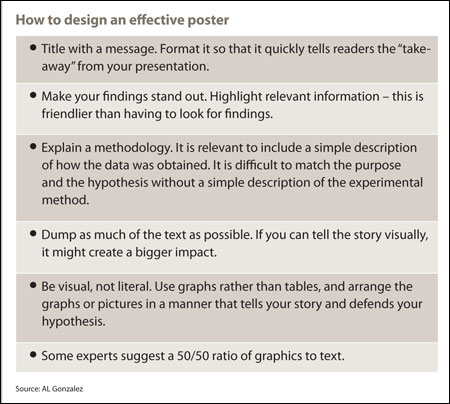How to make the most of poster sessions
Whether viewing or presenting a poster, this optometrist said the experience stimulates discussion.
Poster sessions: You either love them or have not figured them out.
If you attend any meeting that has a poster session, you quickly realize that posters are a different way of communicating clinical, research and project findings. Poster sessions deliver a high-quality and specific message and offer a different presenter-audience interaction than podium presentations. They are a snapshot of research intended to engage the reader in a dialog and encourage him or her to learn more.

Conference attendees can view a wide array of posters. For example, the American Academy of Optometry presents posters on its chapters or Special Interest Groups that explain their objectives and provide reasons to get involved. Other posters may outline interesting clinical cases, contact lens research or trends, such as medication prescribing by optometrists.
Navigating a poster session
In an effort to educate the poster-shy, I will share some suggestions on navigating your next poster session.
Posters are grouped by interest. Find a topic that interest you, such as contact lenses, clinical cases, public health, binocular vision, corneal physiology or electrophysiology. Attending posters with a topic you are interested in will make your initial visit much more comfortable.
Do not be shy. Posters allow you to engage the author. It is fascinating hearing stories of how the project and poster content were developed. The interactive engagement and discussion will be insightful and valuable. Who knows, you could be a collaborator in the future.
Be curious, talk and ask questions on the subject. Even if you do not know them, you will find interesting conversations with poster presenters. Make sure you walk away with something that makes you want to try something different or think about the topic in a different manner.
Do not think this is for nerds. You, too, can be an author, but might just need some guidance. Authors are just like you and me; many are even students showcasing cases they have seen in clinic. Authors are willing to share their story, and faculty authors could even help you by being a mentor.
Presenting a poster
For the researcher and clinician, posters are a great way to show your peers what you do and even share a special case you managed. As a poster junky, I have a few suggestions for those who get posters accepted to the next meeting and will be presenting for the first time.
Posters serve to advertise what you do. Start with the title and the frame of mind to explain in a simple manner what you are adding to current knowledge or what you want to share.
Explain methods in a simple manner; your poster is a short story.
Describe the question and major findings to interest the reader in starting a conversation about the subject matter and your work.
Limit your text and maximize graphics and images. Remember, posters are intended to be a more visual story medium.
Use colors that engage but are easy to read. I have seen many loud colors and crowded backgrounds that distract from the message. I suggest using only two or three colors of dark text on a light background.
Be ready. Have a 2- to 3-minute “elevator speech” in place that explains your motive and findings or recommendations in a short concise manner but encourages readers to engage and find out more.
Have your contact information available. From 8.5-inch by 11-inch paper-sized handouts to business cards with telephone number and email, make sure that you are not “that guy with the cool poster I talked to.”
Posters are a springboard

Poster presentations are considered a necessity for academia and are a phenomenal introduction to more elaborate presentations in the future. But this does not mean that posters are less valuable than podium presentations – actually the opposite is true. I believe the power of the poster sessions is that posters tell a more in-depth story of a narrow subject, whereas podium presentations aim to cover the subject in a wider perspective. Keep an eye on details, but think of the big picture.
Posters sessions are all about peers and friendships. It is fascinating how many people I have met through the years and how often information is exchanged between us.
Oftentimes conversation in the poster sessions among peers and other poster presenters can provide new points of view that can become the springboard for other projects and collaborations. When presenting your poster, make sure to smile and talk to people and have fun, and remember that some people just visit the poster session for the free beer!
So, next time you go to a meeting and they have a poster session, make sure to stop by and browse the posters. You would be surprised at the amount and depth of information available and the engaging discussion you can have with your friendly peers, the authors. Who knows? Maybe next time I will be talking with you!
- For more information:
- Agustin L. Gonzalez, OD, FAAO, can be reached at AG@TXEyeDr.com.
Disclosure: Gonzalez is a managing partner in www.FourTimes52.com.
